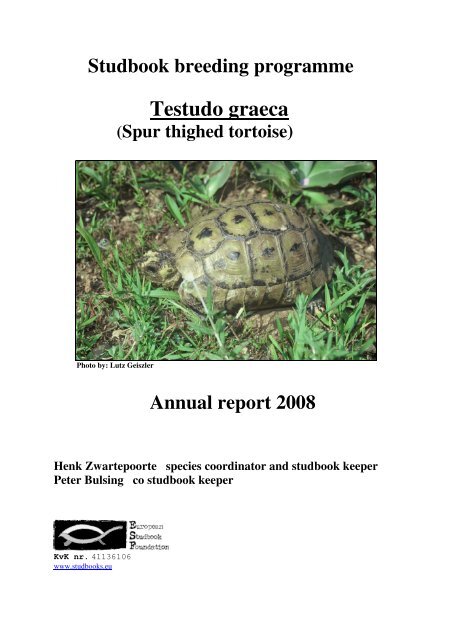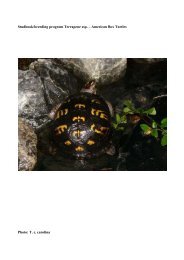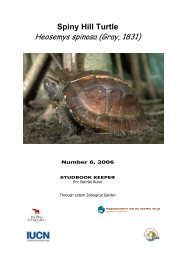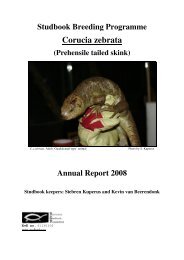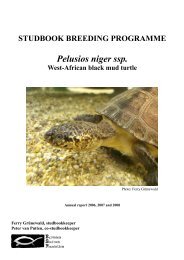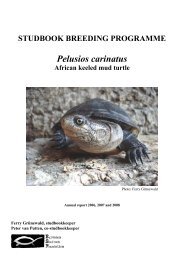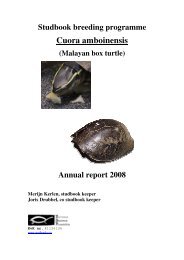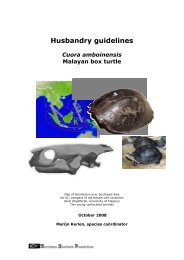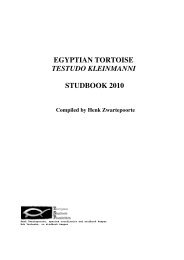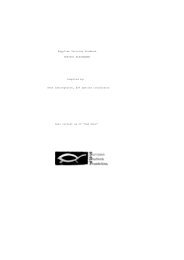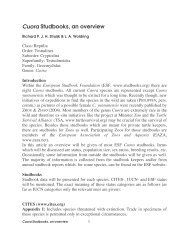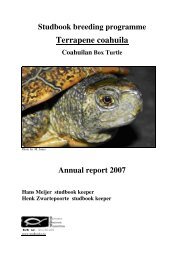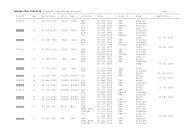Testudo graeca - European Studbook Foundation
Testudo graeca - European Studbook Foundation
Testudo graeca - European Studbook Foundation
You also want an ePaper? Increase the reach of your titles
YUMPU automatically turns print PDFs into web optimized ePapers that Google loves.
<strong>Studbook</strong> breeding programme<br />
<strong>Testudo</strong> <strong>graeca</strong><br />
(Spur thighed tortoise)<br />
Photo by: Lutz Geiszler<br />
Annual report 2008<br />
Henk Zwartepoorte species coordinator and studbook keeper<br />
Peter Bulsing co studbook keeper<br />
KvK nr. 41136106<br />
www.studbooks.eu
Contents:<br />
1. Introduction and activities between 2007 and 2008.<br />
2. <strong>Studbook</strong> population<br />
3. Locations<br />
4. Births<br />
5. Imports<br />
6. Deaths<br />
7. Transfers<br />
8. Discussion<br />
1. Introduction and activities 2007 - 2008.<br />
The frequency of annual studbook reports became a little out of balance during<br />
the last few years. Several reasons and causes can be assessed for this. The<br />
studbook population established during the last five years became pretty stable.<br />
The number of deaths decreased and there were not many births reported. This<br />
last topic is partly caused by the advice from the studbook keeper not to<br />
reproduce with haplotype no. 1. Further reason is the very low process of DNA<br />
research of the confiscated specimens in the Netherlands held at the rescue<br />
centre for a number of years; several animals stay at the centre for almost 4<br />
years now. Additional reason to this was the fact that the DNA research was<br />
stopped by the AMC in Amsterdam and taken over by the University of Ghent<br />
in Belgium. Methods and procedures used by the AMC had to be used in Ghent<br />
as well and this took several months. For a number of years no annual studbook<br />
reports were issued for this species.<br />
After a thorough clean up in the first half of 2007 in which a number of<br />
studbook participants who were not communicating with and not reporting to<br />
the studbook keeper and/or not having tortoises anymore, a more stable<br />
studbook participants group is established now. However still a number of<br />
participants will unfortunately be removed from the studbook during 2009.<br />
At present the studbook counts 43 participants in 5 <strong>European</strong> countries: The<br />
Netherlands (28), United Kingdom (2),Finland (1), Spain (1), Belgium (3),<br />
Germany (1).<br />
During the existence of the studbook 4 zoos were involved in the studbook,<br />
however, only Rotterdam Zoo is actively participating by transferring animals to<br />
ESF participants. The zoos of Amersfoort, Emmen and Jersey offered specimens<br />
to the studbook either as participant or just by donating specimens directly to<br />
private studbook participants. Very welcome to see that over the last few years<br />
these 3 zoos are playing a much more active role in this.<br />
<strong>Studbook</strong> population:<br />
At present at December 31, 2008 the living population counts 57.71.47(175)<br />
specimens, meaning an increase of studbook specimens of 24. The total
studbook population including all reported specimens between 1997 and 2008<br />
counts 125.120.122 (367) specimens. In the 2006-2007 report explanation of<br />
these figures including births, deaths and lost to follow up were explained.<br />
Priority aim for 2007 and 2008 was the accurate update of all studbook<br />
participants and specimens.<br />
With this respect the first steps were taken and the studbook population looks<br />
more healthy now in a sense of stable collections with more and more good<br />
communicating participants.<br />
Between 1997 and 2007 it became more and more clear that the North African<br />
“subspecies” <strong>Testudo</strong> <strong>graeca</strong> <strong>graeca</strong> was not a clear subspecies based on the<br />
whole Northern African population. Earlier, the subspecies <strong>Testudo</strong> <strong>graeca</strong><br />
ibera was classified by a number of taxonomists as a separate species <strong>Testudo</strong><br />
ibera. During the last 10 years on a significant number of studbook specimens a<br />
DNA research was carried out. All participants voluntarily financed this<br />
research which was carried out by the AMC faculty in Amsterdam by ms. Tonja<br />
van der Kuyl (Van der Kuyl, 2000).<br />
During 2008 the University of Ghent in Belgium was asked to proceed this<br />
research in particular important with respect to proper homing of the confiscated<br />
tortoises in the Netherlands. Prof. Dr. Frank Pasmans responded positively to<br />
this request and he and his team did their very best to test several dozens of<br />
samples of confiscated <strong>Testudo</strong> <strong>graeca</strong>.<br />
March 2009 the studbook received the first results making it possible to compare<br />
these results with the morphological identification and transfer these animals to<br />
ESF studbook participants in the course of 2009. The ESF board as well as the<br />
<strong>Testudo</strong> <strong>graeca</strong> studbook are Prof. Dr. Frank Pasmans and his team extremely<br />
grateful for the cooperation.<br />
The taxonomy of <strong>Testudo</strong> <strong>graeca</strong>, in the Northern African region as well as the<br />
Middle East and western Asia is still under discussion. As communicated earlier<br />
elsewhere the ESF <strong>Testudo</strong> <strong>graeca</strong> studbook now focuses only on the North<br />
African population.<br />
Currently within the wild population in Morocco, Algeria, and Libya 4<br />
subspecies are described by Pieh and Perala:<br />
<strong>Testudo</strong> <strong>graeca</strong> cyrenaica (Pieh and Perala, 2002),<br />
<strong>Testudo</strong> <strong>graeca</strong> soussensis (Pieh, 2000),<br />
<strong>Testudo</strong> <strong>graeca</strong> lamberti (Pieh and Perala, 2004),<br />
<strong>Testudo</strong> <strong>graeca</strong> marrokensis (Pieh and Perala, 2004).<br />
From Tunesia by Highfield <strong>Testudo</strong> nabeulensis is described (Highfield, 1990).<br />
The validity of this newly described species was not internationally accepted<br />
and still is not, although in 2002 Pieh and Perala consider the species<br />
nabeulensis as a subspecies of T. <strong>graeca</strong>.<br />
The originally described subspecies T.g.<strong>graeca</strong> still is valid for a specific type in<br />
Morocco; the number of subspecies is now 6.
Furthermore the types <strong>Testudo</strong> whitei BENNETT, 1836 and <strong>Testudo</strong><br />
flavominimaralis HIGHFIELD & Martin, 1989 are still discussed and by some<br />
people considered as a valid species or subspecies. Pieh and Perala however<br />
consider these taxa as nomina dubia.<br />
Over the last few years all studbook participants were asked to send photo’s of<br />
their animals. From these photos collected a large number of specimens with an<br />
emphasis on head shape, colour and shape of both carapace and plastron and<br />
scute formations on both front and backside of the front legs a significant<br />
number could be determined. And they now partly correlate with the recent<br />
received DNA results. Bulsing already earlier started to make line drawings of<br />
these scute formations which is published Bulsing and Zwartepoorte in Trionyx<br />
(2007).<br />
3. Locations:<br />
At present 43 participants at 5 <strong>European</strong> countries are registered. The majority<br />
originating from The Netherlands (28), furthermore there are participants in<br />
Belgium (3), Finland (2), United Kingdom (2), Germany (1) Spain (1).<br />
As stated earlier in previous annual reports still a number of studbook<br />
participants do not report mutations within their collection and/or do no report<br />
deaths and births.<br />
With respect to the privacy factor it was the intention to change all collection<br />
names into a codename. This turned out to be a tremendous job and turned out to<br />
be not feasible during 2008. The participants however received a codename. In<br />
the Sparks report 2009 to be issued in 2010 all current location names will be<br />
changed into numbers. These numbers will only be known within the studbook<br />
and by the studbook keeper. If participants also prefer to remain unknown<br />
within the studbook they have to report this to the studbook keeper.<br />
4. Births:<br />
In 2008 only one birth is reported.<br />
5. Imports:<br />
Deliberate imports of wild caught animals are not reported to the studbook.<br />
The Sparks software programme however considers new entries into the<br />
studbook as imports and as such these imports will be reported and discussed<br />
here.<br />
By an animal rescue organisation in Numansdorp, the Netherlands two<br />
abandoned animals were deposited into the collection of a studbook participant.<br />
These animals will be legalized, will become ESF property and placed out on<br />
loan on the recipients/participants location.<br />
At the studbook keepers location two abandoned animals were brought in. The<br />
animals will be DNA tested and a new location will be sought and legalized and<br />
as such become ESF-property.
In the UK one participant received one new animal.<br />
6. Deaths:<br />
During 2007 1.0.1 (2) deaths were reported; during 2008 these numbers were<br />
1.0.5 (6).<br />
These 2007 and 2008 deaths mostly concerned confiscated specimens.<br />
In general the cause of death is very unclear. No autopsy reports were received<br />
by the studbook.<br />
For the confiscated dead tortoises there might be a suspected reason. Between<br />
moment of capture, mainly occurring in North African countries such as<br />
Morocco and Tunisia and the moment of arrival at the studbook participants<br />
collections lies often a long period.<br />
The time between collecting from the wild and the arrival at Dutch airports or<br />
borders is unknown but one can assume that this will often take weeks or<br />
months. Directly after confiscation the animals go to a holding/rescue centre in<br />
The Netherlands where they remain until a court verdict has been made.<br />
If the verdict says that the animals are free and thus available for further transfer<br />
to ESF, the IBG bureau offers the animals to the studbook. The studbook keeper<br />
looks for interested and suitable locations. For this purpose we have to know:<br />
the sex, size, species or subspecies and DNA haplotype.<br />
Before this information is obtained, quite often many months will go by and in<br />
the meantime we know that this period is sometimes up to 4 years. This is a very<br />
undesirable and unwanted situation. At the rescue/holding centre the animals are<br />
housed under non-optimal conditions; something the rescue centre can not be<br />
blamed for.<br />
Furthermore several long lasting bureaucratic procedures by both the IBG and<br />
CITES authorities and the rescue/holding centre is cause for further delay.<br />
An adjusted protocol is recently proposed to the responsible Dutch IBG<br />
authority by the ESF board to shorten this holding period in The Netherlands.<br />
During 2008 this proposed protocol was agreed on by the IBG bureau and from<br />
this side a significant progress can be seen. Still the juridical procedures takes<br />
far too long.<br />
The cause of death of a significant number of confiscated animals is not always<br />
clear, but what we do see in the dead animals is that post mortem is impossible<br />
in a large number of cases because of the autolytic state.<br />
This situation makes it very difficult to assess a cause of death.<br />
To improve this during 2008 an independent vet is approached to carry out<br />
autopsies. Also the veterinary faculty in Utrecht is found to be prepared to do<br />
the same.<br />
A protocol will be communicated on a wider ESF-level to all studbook<br />
participants and studbook keepers during 2009 how to act in case of dead<br />
animals.
7. Transfers:<br />
Within the studbook 5 animals has been transferred. It concerned all confiscated<br />
specimens; one participant received 4 confiscated ESF animals and one new<br />
participant received a long term ESF animal already at one of the ESF-board<br />
members collection for several years.<br />
8. Discussion:<br />
Major aim for this year is an increased assessment of the different DNA -<br />
haplotypes. Perhaps further development on the taxonomy regarding assessment<br />
of subspecies within the Northern African region re-dividing of the studbook<br />
population into subspecies will be possible and necessary. See for this the article<br />
by Fritz et al (2009).<br />
During 2008 all <strong>Testudo</strong> studbook participants are informed by several email<br />
report messages.<br />
Another important aim to establish an on-line photo gallery of the existing<br />
subspecies and/or DNA- haplotypes in the wild is not finished yet. A second<br />
photo collection will be compiled by the studbook keeper of the present<br />
studbook specimens. A large number of photos is already digitally sent to the<br />
studbook. Those participants who did not so far will be reminded soon in spring<br />
2009.<br />
Photos of head, plastron, carapace and scutes on front- and backside of the front<br />
legs are required.<br />
Those current studbook tortoises not yet DNA tested so far have to done as soon<br />
as possible. The participants will be reminded soon in spring 2009.<br />
Costs are now assessed at €50 per sample. Co operation will be voluntarily but<br />
a contribution into the costs will be asked. A genetically healthy studbook<br />
population is desperately needed acquiring an ex situ assurance population from<br />
which future re-introduction into the wild can be carried out. This of course<br />
under strict IUCN guidelines regarding this and after thorough health checks and<br />
quarantine periods.<br />
Reproduction of <strong>Testudo</strong> <strong>graeca</strong> has proved to be very possible and even led to a<br />
situation that a non-breeding advise had to be given in 2000. Finding new<br />
participants turned out to be impossible and yet at present not an easy task.<br />
With the situation now that half of the captive born numbers died (4) or had to<br />
be considered as “lost to follow up” (23) meaning that they simply disappeared<br />
from the studbook, breeding of at least a number of the DNA- haplotypes is<br />
necessary again. An advise accompanied by a motivation will be published and<br />
communicated to the participants this year.<br />
Aim is to enlarge the number of participants to 50 with an estimated studbook<br />
population between 300 and 400 specimens. The different subspecies and DNAhaplotypes<br />
will be taken into account regarding this.<br />
Very undesirable and illegal are the ongoing imports of North African tortoises<br />
from in particular Marocco. This situation is presented by me at the
TRAFFIC/EU Twix workshop on illegal trade of reptiles in Tarvisio/Italy in<br />
February 2009 and at the EAZA Reptile Taxon Advisory Group in<br />
Ljubljana/Slovenia in April this year.<br />
Cooperation and participation with EAZA institutions (<strong>European</strong> Zoos) is vital<br />
and highly demanded.<br />
Current participation with zoos is highly appreciated. Both EAZA and ESF are<br />
supposed to participate as equal Turtle Survival Alliance (TSA) partners<br />
building the Turtle Arch.<br />
A viable ex situ population of this very attractive species must belong to the<br />
possibilities and the studbook keepers call upon you as studbook participants to<br />
achieve this goal.<br />
Further reading:<br />
Bulsing P. (2000): De Noord Afrikaanse moorse landschildpad (<strong>Testudo</strong> g.<br />
<strong>graeca</strong>) toch een probleemloze schildpad. Special ter gelegenheid van het 125-<br />
jarig bestaan van de Nederlandse Schildpadden Vereniging: 27-31.<br />
Bulsing P. en H.A. Zwartepoorte (2007): Herkenning van enkele types van<br />
<strong>Testudo</strong> <strong>graeca</strong> uit Marocco, Algerije en Tunesie: Trionyx ().<br />
Ballasina D.L.Ph., A.C. van der Kuyl, J.T. Dekker, J. Maas, R.E. Willemsen en<br />
J. Goudsmit (2001):<br />
Phylogenetic relationships among the species of the genus <strong>Testudo</strong> (Testudines:<br />
Testudinidae) inferred from mitochondrial 12S rRNA Gene sequences, Congres<br />
International Sur le genre <strong>Testudo</strong> –<br />
7 au 10 mars 2001 Hyeres – France / Actes du Congres.<br />
Fritz U, D.James Harris, Soumia Fahd, Rachid Rouag, Eva Gracia Martinez,<br />
Andres Gimenez Casalduero, Pavel Siroky, Mohsen Kalboussi, Tareek B.<br />
Jdeidi, Anna K. Hundsdorfer (2009) :<br />
Amphibia-Reptilia 30 (2009) : 63 :80.<br />
Harris D.J., M. Znari, J.C. Mace, M.A. Carretero (2003) : Genetic variation in<br />
<strong>Testudo</strong> <strong>graeca</strong> from Morocco estimated using 12S rRNA DNA sequensing.<br />
Revista Espagnola de Herpetologia, 17: 15-9.<br />
Highfield, A.C. & Martin J. (1989): Description of a miniature tortoise <strong>Testudo</strong><br />
flavominimaralis n. species from North Africa. The Tortoise Trust, London; 4 S.<br />
Pieh A. (2002): <strong>Testudo</strong> <strong>graeca</strong> soussensis, eine neue Unterart der Maurischen<br />
Landschildkrote aus dem Sousstal (Sudwest-Marokko). Salamandra 36(4) : 209-<br />
222.<br />
Pieh A., J. Perala (2004) : Variabilitat de Maurischen Landschildkroten (<strong>Testudo</strong><br />
<strong>graeca</strong> – LINNEUS, 1758 – Komplex) im Zentralen und nordwestlichen<br />
Marokko mit Beschreibung zwei neuer Taxa. Herpetozoa 17 (1/2): 19-47.<br />
Fritz U., A.K. Hundsdorfer, P. Siroky, M. Auer, H. Kami, J. Lehmann, L.F.<br />
Mazanaeva, O. Turkozan, M. Wink (2007): Phenotypic plasticity leads to<br />
incongruence between morphology-based taxonomy and genetic differentiation
in western Palaearctic tortoises (<strong>Testudo</strong> <strong>graeca</strong> complex; Testudines,<br />
Testudinidae). Amphibia-Reptilia 28 (2007): 97-121<br />
Hufer H. & Buddenfeld V. (2000): Haltung und Zucht der Tunesischen<br />
Landschildkrote. Radiata, Rheinbach; 9 (20): 3-14.<br />
Pieh A. & Jarmo Perala (2002): Variabilitat von <strong>Testudo</strong> <strong>graeca</strong> LINNAEUS,<br />
1758 im ostlichen Nordafrika mit Beschreibung eines neuen Taxons von der<br />
Cyrenaika (Nordostlibyen). Herpetozoa 15 (1/2): 3-28.<br />
Zwartepoorte H.A. (2000): Project DNA-typering moorse landschildpad<br />
(<strong>Testudo</strong> <strong>graeca</strong>). Special ter gelegenheid van het 125-jarig bestaan van de<br />
Nederlandse Schildpadden Vereniging: 24-26.<br />
May 2009.<br />
Henk Zwartepoorte, studbook coordinator and studbook keeper.<br />
Peter Bulsing, co-studbook keeper.


